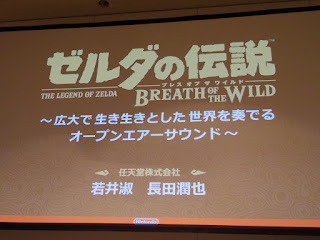 |
| "The Open Air Sound Playing a Massive, Breathing World" |
They required the kind of sound design that would heighten the immersion of being in Hyrule, relaying the rules of the world and the material of the objects located within, and the sense of air flowing through that world. It was something the sound director couldn’t explain with words, so he chose to make a concept video during production to help explain this and shared it with the composers, sound designers, programmers, planners and artists.
 |
| Sound Director, Yoshii Wakai |
The base noise — the foundation for all environmental noise is a faint air sound which changes depending on whether you’re indoors or out, or near water, and also changing base on nearby plant life, time, organic activity or rain.
For music, they started with the idea to restructure what music really means for a Zelda game. So they first chose not to play a looping song on the over-world. This meant that they’d place an emphasis on the environmental sounds — those being the only thing you would always hear. With this they found that they were missing something — nothing to accent certain moments, that feeling of arriving somewhere special. So they chose to play music at special places, and to play random phrases occasionally to break up the monotony. In doing this it’s less apparent that the music has looped over a long period of time.
This still felt too simple, so they chose to play music in places like villages. They made these songs dense, made them all unique, and placed them as emitters on specific areas of the map to make it feel like you were in just one place of a vast world. These emitters were made so as not to feature any special progression, then change from this environmental music in stages as you proceed into the area, which also expands the role of the field’s design.
All the different music and sound effects were each given a priority and volume to help decide what should take precedence and when — note how environmental sound effects stop momentarily while in battle.
 |
| Programmer, Junya Nagata |
They realized this would be devastating to the project, so to avoid that they improved their workflows, using tools, libraries, working between sections so as not to burden the sound team with work they wouldn’t have to do.
They introduced three tools into the mix: SLink, allowing designers to click an actor in game with their mouse and bring up a sound table where they could then specify their sound and test it out — which also worked for animation. AssetBinder, their asset manager tool with search, filter, single and batch volume adjustment, automatic conversion and version control.
They also decided to “leave it up to machine” in regards to tasks to minimize necessary work, using Jenkins to randomly place sound emitters for the environmental sounds throughout the field. This allowed for various parameters such as only placing bird chirping around trees, but not small trees, stumps or dead trees. Finally, they made it so that non-sound members could set sounds as well — so allowing the scenario writers to set cutscene voice, for instance.









No comments:
Post a Comment